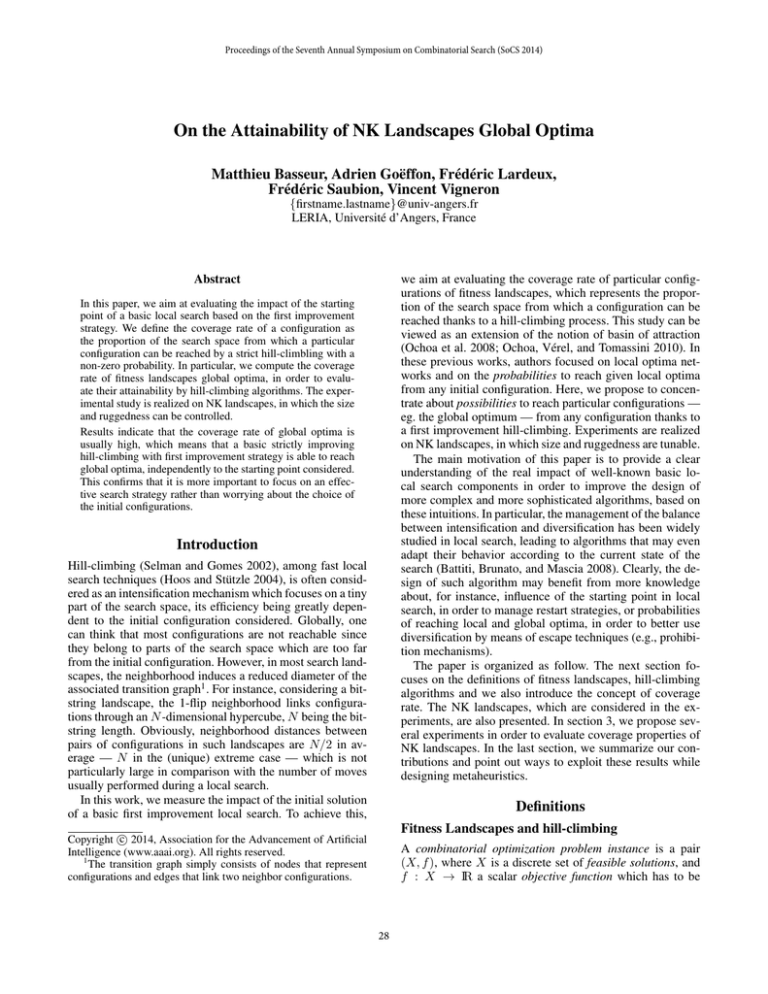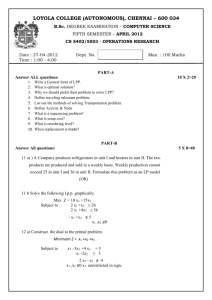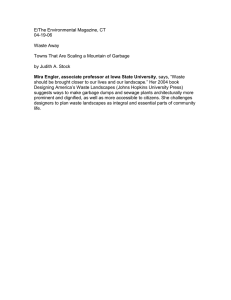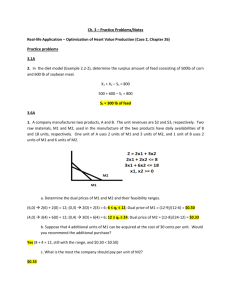
Proceedings of the Seventh Annual Symposium on Combinatorial Search (SoCS 2014)
On the Attainability of NK Landscapes Global Optima
Matthieu Basseur, Adrien Goëffon, Frédéric Lardeux,
Frédéric Saubion, Vincent Vigneron
{firstname.lastname}@univ-angers.fr
LERIA, Université d’Angers, France
Abstract
we aim at evaluating the coverage rate of particular configurations of fitness landscapes, which represents the proportion of the search space from which a configuration can be
reached thanks to a hill-climbing process. This study can be
viewed as an extension of the notion of basin of attraction
(Ochoa et al. 2008; Ochoa, Vérel, and Tomassini 2010). In
these previous works, authors focused on local optima networks and on the probabilities to reach given local optima
from any initial configuration. Here, we propose to concentrate about possibilities to reach particular configurations —
eg. the global optimum — from any configuration thanks to
a first improvement hill-climbing. Experiments are realized
on NK landscapes, in which size and ruggedness are tunable.
The main motivation of this paper is to provide a clear
understanding of the real impact of well-known basic local search components in order to improve the design of
more complex and more sophisticated algorithms, based on
these intuitions. In particular, the management of the balance
between intensification and diversification has been widely
studied in local search, leading to algorithms that may even
adapt their behavior according to the current state of the
search (Battiti, Brunato, and Mascia 2008). Clearly, the design of such algorithm may benefit from more knowledge
about, for instance, influence of the starting point in local
search, in order to manage restart strategies, or probabilities
of reaching local and global optima, in order to better use
diversification by means of escape techniques (e.g., prohibition mechanisms).
The paper is organized as follow. The next section focuses on the definitions of fitness landscapes, hill-climbing
algorithms and we also introduce the concept of coverage
rate. The NK landscapes, which are considered in the experiments, are also presented. In section 3, we propose several experiments in order to evaluate coverage properties of
NK landscapes. In the last section, we summarize our contributions and point out ways to exploit these results while
designing metaheuristics.
In this paper, we aim at evaluating the impact of the starting
point of a basic local search based on the first improvement
strategy. We define the coverage rate of a configuration as
the proportion of the search space from which a particular
configuration can be reached by a strict hill-climbling with a
non-zero probability. In particular, we compute the coverage
rate of fitness landscapes global optima, in order to evaluate their attainability by hill-climbing algorithms. The experimental study is realized on NK landscapes, in which the size
and ruggedness can be controlled.
Results indicate that the coverage rate of global optima is
usually high, which means that a basic strictly improving
hill-climbing with first improvement strategy is able to reach
global optima, independently to the starting point considered.
This confirms that it is more important to focus on an effective search strategy rather than worrying about the choice of
the initial configurations.
Introduction
Hill-climbing (Selman and Gomes 2002), among fast local
search techniques (Hoos and Stützle 2004), is often considered as an intensification mechanism which focuses on a tiny
part of the search space, its efficiency being greatly dependent to the initial configuration considered. Globally, one
can think that most configurations are not reachable since
they belong to parts of the search space which are too far
from the initial configuration. However, in most search landscapes, the neighborhood induces a reduced diameter of the
associated transition graph1 . For instance, considering a bitstring landscape, the 1-flip neighborhood links configurations through an N -dimensional hypercube, N being the bitstring length. Obviously, neighborhood distances between
pairs of configurations in such landscapes are N/2 in average — N in the (unique) extreme case — which is not
particularly large in comparison with the number of moves
usually performed during a local search.
In this work, we measure the impact of the initial solution
of a basic first improvement local search. To achieve this,
Definitions
Fitness Landscapes and hill-climbing
c 2014, Association for the Advancement of Artificial
Copyright Intelligence (www.aaai.org). All rights reserved.
1
The transition graph simply consists of nodes that represent
configurations and edges that link two neighbor configurations.
A combinatorial optimization problem instance is a pair
(X, f ), where X is a discrete set of feasible solutions, and
f : X → IR a scalar objective function which has to be
28
X, pxopt (x) > 0}, where pxopt (x) represents the probability
to reach xopt from x as starting point and using the given
hill-climbing strategy (Ochoa, Vérel, and Tomassini 2010).
Note that this definition is restricted to local optima only
but can actually be generalized to any configuration of the
search space.
In (Ochoa, Vérel, and Tomassini 2010), the size of a
basin ofPattraction Bxopt is defined as the sum of probabilities x∈X pxopt (x). Authors do not define the size of
a basin of attraction as its cardinality, in order to represent
the probability for a given local optimum to be attained by
a hill-climbing, which starts from a random configuration
size(Bxopt )
(the global probability is actually
). In this paper,
#X
we will focus on the cardinality of basins of attraction in
order to determine the possibility of reaching a given local
optimum. Thus, we introduce the coverage rate γ(x) of a
configuration x ∈ X as the proportion of the search space
that belongs to its basin of attraction:
maximized or minimized. In a maximization context, solving (X, f ) consists in finding x? ∈ argmaxx∈X f (x).
A fitness landscape is a triplet (X, N , f ), where X is a
set of configurations called search space, N : X → 2X is
a neighborhood function, and f is a fitness function. f (x) is
the fitness of x. x0 ∈ N (x) is a neighbor of a configuration
x ∈ X. N (x) is the neighborhood of x. A local optimum is
a configuration x such that ∀x0 ∈ N (x), f (x0 ) 6 f (x). A
global optimum is a configuration x? ∈ argmaxx∈X f (x).
A local search algorithm aims at finding the best configuration of X (thanks to f ) while exploring a subset of X relatively to (X, N , f ). A hill-climbing algorithm is a basic local search strategy which navigates through the search space
in allowing only non-deteriorating moves. Given an initial
configuration called starting point, a basic hill-climbing algorithm iteratively moves to better neighbors, until it reaches
a local optimum. We consider here the most stochastic basic hill-climbing strategy, first improvement, which accepts
at each iteration the first evaluated neighbor which satisfies
the moving condition (see algorithm 1). Other well-known
strategy, best improvement, is not considered here, since its
(globally) deterministic aspect will not distinguish possibilistic and probabilistic cases. Moreover, in (Basseur and
Goëffon 2013), it has been shown that first improvement often outperforms best improvement on a wide variety of landscapes.
γ(x) =
#Bx
#X
NK Landscapes
The NK family of landscapes (Kauffman and Weinberger
1989) is a problem-independent model for constructing multimodal landscapes. NK-landscapes use a basic search space,
with binary strings as configurations and bit-flip as neighborhood (two configurations are neighbors iff their Hamming distance is 1). Characteristics of an NK landscape are
determined by two parameters N and K. N refers to the
size of binary string configurations, which defines the search
space size (|X| = 2N ). K specifies the ruggedness level of
the landscape; indeed, the fitness value of a configuration is
given by the sum of N terms, each one depending on K + 1
bits of the configuration. Thus, by increasing the value of K
from 0 to N − 1, NK landscapes can be tuned from smooth
to rugged.
In NK landscapes, the fitness function f : {0, 1}N →
[0, 1) to be maximized is defined as follows.
input : a fitness landscape (X, N , f ), a starting point
x0 ∈ X
output: a local optimum xopt and its fitness Fopt
F ← f (x0 )
N ← N (x0 )
while N 6= ∅ do
Randomly selects x0 ∈ N
F 0 ← f (x0 )
if F 0 > F then
x ← x0
F ← F0
N ← N (x)
end
else
N ← N \ {x0 }
end
end
xopt ← x
Fopt ← F
return (xopt , Fopt )
f (x) =
N
1 X
ci (xi , xi1 , . . . , xiK )
N i=1
(1)
where ci : {0, 1}K+1 → [0, 1) defines the component function associated with each variable xi , i ∈ {1, . . . , N }, and
where K < N .
NK landscapes instances are determined by the (K + 1)uples (xi , xi1 , . . . , xiK ) as well as the 2N (K + 1) ci result values corresponding to a fitness-contribution matrix C
whose values are randomly generated in [0, 1) and following
the random neighborhood model (Kauffman and Weinberger
1989).
In the following, we study NK landscapes to extract information about coverage rates. Let us recall that a coverage
rate is defined with respect to a landscape and a move strategy. In this paper, we focus on the first improvement strategy.
Experiments will be carried out on various landscapes
classified with respect to their size and ruggedness. We
Algorithm 1: Basic first improvement hill-climbing.
More details about hill-climbing and various stochastic
local search techniques can be found in (Hoos and Stützle
2004).
Basins of attraction and coverage rate
Given a fitness landscape (X, N , f ) and a hill-climbing
strategy (first or best improvement), the basin of attraction of a local optimum xopt is the set Bxopt = {x ∈
29
first focus on studying coverage rate properties of N Klandscapes on small instances in order to provide exact results, which will help us to extrapolate such properties on
larger landscapes.
once. Combined with a treatment of solutions by decreasing fitness, this representation allows to free memory during
the search, by deleting solutions which cannot appear afterwards (see algorithm 2).
Results
Coverage rate of NK landscape global optima
Table 1 presents the coverage rates obtained on small NK
landscapes instances. By focusing on the column LO1 ,
which corresponds to the coverage rates of global optima,
one may observe that the average rate is greater than 70%
for all (N, K) parameterizations. The smallest coverage result (70.17%) is obtained on a rugged instance (K = 8),
which can be classified as difficult. Nevertheless, the average global optima coverage rate on rugged NK landscapes
remains relatively high. Considering average rates according to the landscapes ruggedness, we observe that the greater
values are obtained for K = 4. This result is quite surprising
since one would expect to get the best coverage for the least
rugged instances (K = 2), even if standard deviations are
higher.
An interesting point is that global optima coverage rates
are high and their variation between NK instances are relatively low. It means that global optima can be attained with
basic hill-climbings from most initial configurations. This
result seems to be not dependent to the size of the search
space, and we can expect that this remains valid for wider
landscapes.
During experiments, we observed the distribution of solutions according to their fitness, considering if they belong
or not in the coverage of the global optimum. By this way,
we are able to visualize the correlation between coverage
rates and configuration fitnesses, as shown in figure 1. This
figure emphasizes that the global optimum is almost always
attainable from the worst configurations of the search space,
which is intuitively understandable since it allows the generation of many possible improving paths. At the contrary,
it is less often possible to reach the global optimum when
starting from a configuration with a high fitness.
Let us notice that a high coverage does not mean that the
global optimum is easily attainable, but refers to the possibility to reach it. In the next section, we focus on the probability
of reaching global optima from randomly selected solutions.
This section aims at calculating the coverage rate of NK
landscape global optima by performing a first improvement
hill-climbing. A high coverage rate means that an effort for
determining an appropriate initial solution is not necessarily useful. Indeed, this would mean that a randomly chosen
solution would have a high probability of having a chance to
reach the global optimum.
Methodology
The coverage rate computation of a global optimum first
requires to solve the optimization problem itself. For each
NK landscape instance considered in the results section,
the global optimum is obtained by means of an exhaustive
search. To compute exactly the coverage rate of the global
optimum, we determine all possible reverse hill-climbing
paths from the optimum as starting point.
input : a fitness landscape (X, N , f ) and its global
optimum s?
output: the coverage rate of s?
cardcov ← 1
f˜ ← bf (s? ).Hc //f˜ is the integer transformation of f in
the interval {0..H − 1}, where H is the hash table size
InsertSol(HashTable,f˜,s? )
for i ← f˜ to 0 do
foreach s ∈ SolSet(HashTable,i) do
foreach s0 ∈ N (s) do
j ← bf (s0 ).Hc // a solution is inserted if
the fitness is deteriorated and if this solution
is not already recorded;
if j < i then
if not FindSol(HashTable,j,s0 ) then
InsertSol(HashTable,j,s0 )
cardcov ←cardcov +1
end
end
end
DeleteSolSet(HashTable,i)
end
end
return cardcov/2N ;
Probability of reaching global and local
optima
Previous results show that the global optimum is achievable
with a hill-climbing from most solutions of the search space.
However, this does implies a significant probability to reach
it. This section aims at computing the probabilities to reach
each local optimum, ie. the size of their basin of attraction.
Algorithm 2: Computation of a coverage rate.
Methodology
A basic approach is to recursively generate deteriorating
neighbors until reaching a local minimum, while counting
the number of distinct configuration considered. However
such an approach is intractable since most solutions belong to numerous hill-climbing paths. The use of a hash
table which considers fitness as hash function will allow
us to effectively ensure that each solution is handled only
The computation of the probability of achieving a particular
configuration (eg. the global optimum) cannot be achieved
by exhaustively testing all possible paths from all possible
starting points. Here, we propose to compute the probability
to reach a configuration from a single random starting point.
An estimation of the expected probability will be obtained
30
Instance
1
2
3
4
5
6
7
8
9
10
Avg
SD
Global
N = 16
K=2
K=4
K=8
94.37% 91.49% 68.38%
55.72% 86.68% 74.82%
90.95% 86.90% 74.26%
67.83% 92.95% 66.99%
54.65% 88.79% 69.38%
74.98% 87.76% 68.52%
68.91% 87.81% 69.40%
74.03% 87.19% 66.75%
96.78% 91.07% 71.34%
78.67% 87.83% 71.86%
75.69% 88.85% 70.17%
14.86% 2.19%
2.82%
Avg: 78.23%; SD: 11.66%
N = 24
K=2
K=4
K=8
63.19% 95.95% 88.89%
91.93% 96.12% 88.90%
66.19% 95.50% 91.64%
71.55% 95.83% 88.70%
92.42% 94.99% 90.60%
72.44% 97.66% 86.64%
63.63% 94.34% 87.61%
96.92% 96.58% 89.60%
80.10% 92.98% 90.55%
82.39% 96.13% 91.00%
78.08% 95.61% 89.41%
12.57% 1.28%
1.57%
Avg: 87.70%; SD: 10.24%
Table 1: Coverage rates of randomly generated NK landscapes (N ∈ {16, 24} and K ∈ {2, 4, 8}).
solution can be reached from two distinct paths, then we add
the corresponding probabilities.
Algorithm 3 describes how the probability of achieving
an optimum xopt starting from a solution x0 is computed.
coverage rate
basin
search space
1
100000
80000
0.6
60000
0.4
40000
0.2
20000
0
input : a fitness landscape (X, N , f ), a starting point
s0 ∈ X and a target configuration s? ∈ X
output: the probability to reach s? from s0
f˜0 ← bf (s0 ).Hc
f˜? ← bf (s? ).Hc
InsertSol(HashTable,f˜,s0 )
Pr[s0 ] ← 1 // Probability to reach s0 from s0
for f˜ ← f˜0 to f˜? do
foreach s ∈ SolSet(HashTable,f˜) do
foreach s0 ∈ N (s) do
f˜0 ← bf (s0 ).Hc
if f˜0 > f˜ then
if not FindSol(HashTable,f˜0 ,s0 )
then
InsertSol(HashTable,f˜0 ,s0 )
Pr[s0 ] ← Pr[s]/n
end
else
Pr[s0 ] ← Pr[s0 ] + Pr[s]/n
end
end
end
end
DeleteSolSet(HashTable,f˜)
end
return Pr[s? ]
Algorithm 3: Probability to reach a solution s0 .
# configurations
coverage rate
0.8
0
0.2
0.3
0.4
0.5
fitness
0.6
0.7
0.8
Figure 1: Coverage rate of an NK landscape global optimum
(N = 24, K = 2, instance #9, global cov. rate: 80.10%)
with respect to fitness. We indicate, for all fitness values
(range size 10−3 ), the number of configurations belonging to
the basin of attraction of the global optimum (dashed line),
and the total number of configurations of the search space
(dotted line).
by averaging on a sample of starting points. The algorithm
works as follow.
Computing the probability that a configuration x0 reaches
an optimum xopt requires to determine the probability of selection of all improving paths that drive to xopt . In particular, if no search path leads to xopt , the probability will be set
to 0. The probability of following a path will be evaluated
starting from x0 and taking into account all possible local
searches ways. In a first improvement context, we consider
that all improving neighbors have an equivalent probability
to be selected. Thus, if a configuration x has a probability
p to be reached and has k improving neighbors, then the
probability of choosing each of these paths will be p/k. If a
Results
Tables 2, 3 and 4 report the probability of reaching local
optima on NK landscapes, for N = 16. The average prob-
31
Instance
1
2
3
4
5
6
7
8
9
10
Avg
SD
Best
9.54 %
2.49 %
13.43 %
5.04 %
7.89 %
8.14 %
9.46 %
12.09 %
34.89 %
45.43 %
14.84%
13.93 %
10.00 %
14.25 %
10.73 %
13.43 %
16.67 %
17.63 %
24.76 %
28.54 %
12.09 %
34.89 %
45.43 %
21.84%
11.41 %
30.00 %
49.97 %
33.05 %
44.98 %
49.02 %
55.31 %
55.45 %
67.36 %
45.20 %
75.04 %
64.49 %
53.99%
12.35 %
50.00 %
61.79 %
59.86 %
84.58 %
77.65 %
75.03 %
76.76 %
85.14 %
73.59 %
84.90 %
79.76 %
75.91%
8.96 %
Top 5
#LO
43.76 % 20
17.23 % 36
66.86 % 16
21.58 % 49
17.63 % 54
28.17 % 48
20.41 % 81
51.62 % 16
75.04 % 18
64.49 % 19
65.70
35.7
22.55 % 21.93
Cov.
94.37 %
55.72 %
90.94 %
67.82 %
54.65 %
74.98 %
68.91 %
74.02 %
96.77 %
78.66 %
75.69
14.86
Table 2: Probability of achieving different local optima on (N = 16, K = 2) instances. Probabilities are obtained from a
sampling of 100 initial solutions. The probability of reaching each possible local optimum was calculated. The Best column
corresponds to the probability of reaching the global optimum. Columns 10%, 30%, 50% refer to the probability of reaching
respectively the 10%, 30%, 50% best local optima. Top 5 column corresponds to the probability to reach one of the 5 best local
optima. Column #LO indicates the number of local optima of the considered instance. The last column reports the coverage
rate of the global optimum on each considered instance.
Instance
1
2
3
4
5
6
7
8
9
10
Avg
SD
Best
3.69 %
4.23 %
3.29 %
3.64 %
6.02 %
3.81 %
4.56 %
3.28 %
3.89 %
9.28 %
4.57%
1.84 %
10.00 %
35.41 %
27.15 %
36.29 %
24.92 %
32.18 %
26.13 %
35.03 %
29.37 %
37.92 %
37.87 %
32.23%
4.98 %
30.00 %
66.62 %
61.34 %
71.83 %
55.68 %
70.04 %
64.49 %
65.15 %
61.81 %
69.48 %
66.56 %
65.30%
4.79 %
50.00 %
84.05 %
82.95 %
85.27 %
78.67 %
85.72 %
82.06 %
81.66 %
80.22 %
83.50 %
83.12 %
82.72%
2.17 %
Top 5
#LO Cov.
24.17 % 121 91.48
13.70 % 129 86.68
28.76 % 89 86.89
15.09 % 106 92.94
20.39 % 99 88.79
16.45 % 119 87.76
14.74 % 140 87.81
14.65 % 139 87.18
17.59 % 121 91.06
18.45 % 142 87.83
18.40% 120.5 88.85
4.83 % 18.03 2.19
Table 3: Probability of achieving different local optimum on (N = 16, K = 4) instances. See Table 2 for columns description.
Instance
1
2
3
4
5
6
7
8
9
10
Avg
SD
Best
0.54 %
2.76 %
0.57 %
0.61 %
0.20 %
0.90 %
1.11 %
0.56 %
1.60 %
0.59 %
0.94%
0.74 %
10.00 %
26.93 %
31.45 %
27.59 %
30.21 %
27.32 %
25.70 %
32.36 %
30.33 %
31.93 %
31.89 %
29.57%
2.45 %
30.00 %
59.95 %
59.93 %
57.67 %
60.84 %
59.75 %
59.16 %
57.71 %
60.59 %
63.19 %
58.65 %
59.74%
1.63 %
50.00 %
77.52 %
79.53 %
75.97 %
77.41 %
77.76 %
79.13 %
78.28 %
77.94 %
79.00 %
78.15 %
78.07%
1.02 %
Top 5 #LO Cov.
2.92 % 770 68.37
5.18 % 770 74.81
2.47 % 730 74.26
3.46 % 745 66.98
1.10 % 794 69.38
2.51 % 747 68.51
3.20 % 780 69.39
3.50 % 737 66.74
5.00 % 740 71.33
3.06 % 741 71.85
3.24% 755.4 70.17
1.19 % 21.42 2.82
Table 4: Probability of achieving different local optima on (N = 16, K = 8) instances. See Table 2 for columns description.
32
coverage rate
basin
search space
coverage rate
1
15000
0.8
12000
0.6
9000
0.4
6000
0.2
3000
0
0
0
2
4
6
8
distance
10
12
14
16
Figure 2: Average coverage rates of NK landscape global
optima (N = 16, K = 4, 10 instances, global coverage rate:
88.85%) with respect to distances from optimum. We indicate, for all distance values, the average number of configurations belonging to the basin of attraction of each instance
global optimum (dashed line), and the total number of configurations of a search space (dotted line).
Correlation coverage rate vs. neighborhood
distance
This section aims at evaluating the coverage rate of a configuration according to its neighborhood distance to other
configurations. To achieve this, we distinguish different
distance-based coverage rate values of a global optimum
xopt , depending of the neighborhood distance of configurations to xopt . While a correlation between coverage rate and
neighborhood distance is expected, it will be interesting to
determine if coverage rates are still significant from distant
configurations.
Here we will consider the distance-based coverage rates
of global optima only. Let us notice that considering NK
landscapes, neighborhood distances between solutions are
distances, varying from 1 to N . The number of configurations being at a Hamming
distance of d of any particular
configuration is Nd . To compute distance-based coverage
rates, we first split the basin of attraction of xopt into N
subsets with respect to the Hamming distance h : X 2 → IN
between configurations of Bxopt and xopt , and then compute the rates separately. More precisely, the coverage rate
of xopt at distance d is:
rate tends to decrease linearly while the neighborhood distance increases, it remains relatively high even for farest solutions.
Correlation neighborhood distance / search
length
In this section, we aim at comparing the neighborhood
(Hamming) distance between starting points and global optimum with the minimal length of a hill-climbing path linking
these two configurations. A strong correlation could allow
to reduce the computational effort to solve large instances
by focusing on direct (or nearly direct) paths — ie. without
flipping the same bit several times.
The correlation between Hamming distance and search
length is performed on the whole search space. We focus
here on computing this correlation with the global optimum
as target configuration. The principle is similar to the coverage computation provided in section . The set of configurations belonging in the global optimum basin of attraction
is computed thanks to algorithm 2, except that we compute
minimal paths leading to the global optimum. In most cases,
if there is a hill-climbing path to reach the global optimum,
then numerous different search paths can generally be followed.
Results on NK instances (with N ∈ {16, 24}) are reported in table 5. From most configurations belonging to
the global optimum basin of attraction, there exists a direct
hill-climbing path reaching the global optimum in a number of moves corresponding to their neighborhood distance
from the optimum (d). Cumulative results indicate that only
3.4% of configurations of the global optimum basin cannot
reach the optimum in hill-climbing paths of d + 2 moves
#{x ∈ Bxopt , h(x, xopt ) = d}
N
d
Let us precise that the computation of distance-based coverage rates can be included in algorithm 2 by considering N
basin cardinalities rather than a single one.
Figure 2 presents an interesting view of the basin of attraction of an NK landscape global optimum xopt (N = 16,
K = 4). We illustrate here the proportion of configurations belonging to the basin of attraction of xopt with respect to their neighborhood (Hamming) distance of xopt .
One can observe that although the distance-based coverage
33
# configurations
ability to reach the global optimum (best) is relatively low
when K = 4 and K = 8 (respectively 4.5% and 1%).
As expected, global optima’s high coverage rates do not imply high reaching probabilities. For K = 2 landscapes, this
probability is relatively high (more than 10%). Globally, the
probability of reaching the global optimum decreases while
the ruggedness of the problem increases, which is natural
since the number of local optima is greater. Nevertheless, let
us recall that this phenomenon is not present for the covering
rate. Since the probability of reaching the global optimum is
a numerical indicator of the landscape difficulty, this experimentation confirms that the ruggedness level of a landscape
directly affect its difficulty.
The column 50% provides us an additional piece of information. Indeed, for all ruggedness levels, the probability
to reach one of the top 50% local optima is over 70%. This
means that a first improvement hill-climbing globally tends
to converge to high optima of the landscape. Similar conclusion were obtained by Ochoa et al. (Ochoa et al. 2008) which
were focusing on best improvement. They showed that high
local optima benefited from wider basins of attraction than
lower local optima.
N
K
Dist.
Avg
2
SD
Avg
16 4
SD
Avg
8
SD
Avg
2
SD
Avg
24 4
SD
Avg
8
SD
Cumulative avg.
d
91.73%
0.042
89.96%
0.029
81.99%
0.023
88.16%
0.059
91.53%
0.015
87.73%
0.013
88.52%
d+2
6.27%
0.029
7.40%
0.016
12.76%
0.011
7.63%
0.033
6.26%
0.010
8.21%
0.007
96.61%
d+4
1.39%
0.008
1.81%
0.008
3.63%
0.007
2.38%
0.015
1.41%
0.003
2.46%
0.003
98.79%
d+6
0.40%
0.004
0.57%
0.004
1.15%
0.004
0.99%
0.007
0.49%
0.001
0.95%
0.002
99.55%
d+8
0.19%
0.002
0.18%
0.001
0.35%
0.002
0.46%
0.004
0.19%
0.001
0.40%
0.001
99.85%
Table 5: Minimal hill-climbing path length with respect to the initial Hamming distance starting points / global optimum (d).
Considered starting points are configurations belonging to the global optimum basin of attraction. Rates are averaged from the
10 considered instances of each (N ,K) parameterization.
— ie. only one bit is flipped back to its initial value during the search. These observations indicate that if we focus
on local searches which avoid or limit the application of a
move twice during the search (e.g., using prohibition mechanisms), this do not influence significantly the possibility to
reach the global optimum.
to increase the probability to reach the best local optima and
then the average expected final fitness achieved.
References
Basseur, M., and Goëffon, A. 2013. Hill-climbing strategies
on various landscapes: an empirical comparison. In Blum,
C., and Alba, E., eds., GECCO, 479–486. ACM.
Basseur, M., and Goëffon, A. 2014. On the efficiency
of worst improvement for climbing NK landscapes. In
GECCO. ACM.
Battiti, R.; Brunato, M.; and Mascia, F. 2008. Reactive
Search and Intelligent Optimization, volume 45 of Operations research/Computer Science Interfaces. Springer Verlag.
Hoos, H. H., and Stützle, T. 2004. Stochastic Local Search:
Foundations & Applications. San Francisco, CA, USA:
Morgan Kaufmann Publishers Inc.
Kauffman, S. A., and Weinberger, E. D. 1989. The NK
model of rugged fitness landscapes and its application to
maturation of the immune response. Journal of theoretical
biology 141(2):211–245.
Ochoa, G.; Tomassini, M.; Vérel, S.; and Darabos, C. 2008.
A study of NK landscapes’ basins and local optima networks. In Ryan, C., and Keijzer, M., eds., GECCO, 555–
562. ACM.
Ochoa, G.; Vérel, S.; and Tomassini, M. 2010. Firstimprovement vs. best-improvement local optima networks
of nk landscapes. In Schaefer, R.; Cotta, C.; Kolodziej, J.;
and Rudolph, G., eds., PPSN (1), volume 6238 of Lecture
Notes in Computer Science, 104–113. Springer.
Selman, B., and Gomes, C. 2002. Hill climbing search.
Nature Encyclopedia of Cognition, Nature Publ.
Conclusion
In this paper we aimed at extracting information from NK
landscapes concerning the ability of hill-climbings to reach
global optima. To achieve this, we performed an analysis
through exhaustive explorations of NK landscapes. The different experiments realized provide us some interesting conclusions. A first experiment, which aims at evaluating the
attainability of global optima, shows that they are reachable
from most configurations of the search space through a basic
hill-climbing process.
While focusing on the probability to reach the different
local optima of the search space, results showed that a first
improvement reaches more likely higher local optima than
others.
Additional studies extended attainability results by
adding neighborhood distance information. In particular, we
pointed out that even furthest configurations are often able
to reach the global optimum thanks to a strict hill-climbing.
Moreover, by reducing the number of allowed moves, results
indicate that when a solution belongs in the global optimum
basin, in most cases there exists a direct path to attain it. It
means that there often exists a hill-climbing path from an
initial solution to the global optimum where the number of
steps is equal or close to the initial neighborhood distance
between both configurations.
It would be interesting to find a way to estimate the proposed metrics for large of highly rugged landscapes where
we are not able to enumerate all paths exhaustively. Nevertheless, this study lead us to believe that there is possibilities
to improve hill-climbing search efficiency by defining alternative pivoting rules (Basseur and Goëffon 2014), which aim
34








